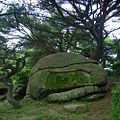Himorogi

Himorogi (神籬, lit. "divine fence") are sacred spaces in Shinto used for worship.
Himorogi are enclosed with shimenawa ropes suspended from poles.[1] There are usually four poles in a square shape.[1] The poles are normally made from green bamboo or sakaki.[1]
At the center of the himorogi is a branch of sakaki or some other type of evergreen, which represents the physical presence of the kami - a divine being that is incorporeal. It is a yorishiro. The himorogi is a simple yet important structure in Shinto worship.[1][2]

The Aoi Festival in Kyoto features a more elaborate version of the himorogi, which is a square area enclosed by green branches and features an evergreen tree at the center as a yorishiro. Another variation of the himorogi involves using a straw mat on the ground and placing a ceremonial 8-legged stand, called an hassoku-an, on top of it. The hassoku-an is adorned with shimenawa and other sacred emblems..[1]
The origin of the word "himorogi" is uncertain, but it is found in ancient Japanese texts such as the Nihon Shoki and the Man'yōshū.[1] In Shinto, the term "himorogi" is used to describe both the sacred space and the tree at the center of the space. Both the tree and the space are considered to be pure and sacred.[3]
In Japan, at construction sites, people often build a Himorogi. It is a sacred space where a Shinto priest comes to bless the site before work begins. The Himorogi is usually left standing for some time after the ceremony. This is a part of a traditional ground-breaking ritual called jichinsai (地鎮祭).
Himorogi Media
A himorogi at Tsurugaoka Hachiman-gū
Himorogi of Amenohohi-no-mikoto at Rokkosan Country House.
Related pages
References
- ↑ 1.0 1.1 1.2 1.3 1.4 1.5 "Encyclopedia of Shinto - Home : Shrine Architecture : Himorogi". 2007-09-30. Archived from the original on 2007-09-30. Retrieved 2023-04-17.
{{cite web}}: CS1 maint: bot: original URL status unknown (link) - ↑ Kōjien, 神籬
- ↑ Bocking, Brian. (1997). A Popular Dictionary of Shinto. p. 41.
Sources
- Bocking, Brian. (1997). A Popular Dictionary of Shinto. Lincolnwood, Illinois: NTC Publishing. ISBN 9780844204253; OCLC 36977290
- Iwanami Kōjien (広辞苑) Japanese dictionary, 6th Edition (2008), DVD version
- Sugiyama, Shigetsugu. "Himorogi". Encyclopedia of Shinto. Retrieved 2008-07-18.


